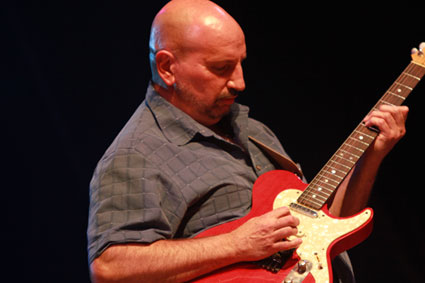by Joe Dalton
When I was 19, I auditioned for Shirley Alston’s group, The Shirelles. The first thing the band leader told me was that the guitar spot require a dynamic soloist who didn’t strum chords to play rhythm. Well, to keep a short story short, I didn’t get the job. I was clueless. Almost all the rhythm parts I knew involved strumming chords. This was the beginning of my quest to find other techniques.
Playing a repeating single-note line instead of strumming chords can be traced back to early rockabilly styles, like the melody of the “Guitar Boogie Shuffle.” The two variations in Examples 1a and 1b put this idea in placeuse heel muting for a percussive effect. The root of the I chord (c) is the highest note instead of the lowest. The same notes work on the IV chord (F). Sometimes you can even use this line on the V CorF chord (GJ, though you may hear the suspended-fourth sound needing to resolve, in which case you’d change the fifth-fret C to a fourth-fret B. You can hear similar rhythm work on Alabama’s “Mountain Music” and Ronnie McDowell’s “Older Women.” You might get some more ideas from Aerosmith’s “Walk This Way.” Read on for the full guitar lesson including audio, charts, Power Tab, and more…
Guitar Lesson
http://truefire.com/audio-guitar-lessons/country-rhythm.mp3
Click here to download the power tab for this guitar lesson.
In Ex. 2, we add double-stops. I use the pick-and-finger approach. Using the fleshy part of my middle and ring fingers, I lift and snap the second and third strings in to the neck. The pick plays the notes on the fourth string. With these double-stops, the Eb works in the C chord (it’s the 3), but you need an Eb in the F chord (it’s the 7).
Ex. 3 is like the electric rhythm part in Dave Dudley’s “Six Days On The Road.” Pick the fifth and sixth strings and use your middle and ring finers to snap the second and third stricks into the neck. On “Amos Moses,” Jerry Reed plays the same kind of part on single strings.
Long sustained notes outline the chords in Ex. 4. The same notes provide different harmonic extensions to each chord. In the first measure, the D# hints at an Emaj7. The second measure G#m
sounds like a G#m6 duet o the strong E presence. The third measure A has the 9 added due to the B. In the last measure, Bsus4 resolves to B. Ex. 5 uses triads to achieve similar results.
Volume swells are the idea in Ex. 6a. You can wrap your pinky around the volume knob or use a pedal. The sustaining whole notes are parts of chords. I usually use the right-hand pick-and-finger technique.
In Ex. 6b, rhythmic volume swells create an effect like amp vibrato-you’ll hear this technique on Keith Whitley’s “Don’t Close Your Eyes.” Volumes wells under bends get you that old crying steel sound, as in Ex. 6c.
The swing bands of the ’30s and ’40s were marked by their tightly arranged, harmonically dense horn parts. The Bob Wills and Leon MacCauliffe Western swing bands transferred these arrangements onto fiddles, guitars, saxes, and steel guitars. You’d hear “horn” parts on two fiddles playing double-stops, on two guitars, on two fiddles plus a steel guitar and a sax-any combination was fair game. In most contemporary country dance bands, carrying this many lead players is economically impossible, so you’ll have to do the whole thing yourself.
Ex. 7a illustrates how to get these section sounds-think horns as you play. The stretches are mean, so you might try this part with the forms in Ex. 7b.
Ex. 7c is a familiar Les Paul lick. You can use this over the I chord (I$ or the IV chord (A) to create movement.
Ex. 8 is a busier part that works with a quick Western-swing groove. The key to making this work is repetition. I’d recommend a pick-and-finger approach.
All these rhythm parts need to be placed properly in the overall mix and volume is just one consideration-make sure your tone blends with the other instruments and voices as well.
Again, repetition is key. I might play the same figure throughout a verse or chorus. With the Western-swing parts, I might play the same part every time the same change comes around instead of in every measure. What I’m saying is, use your ear, creativity, and musical sense to create new parts and to use these ideas in the proper texture.
